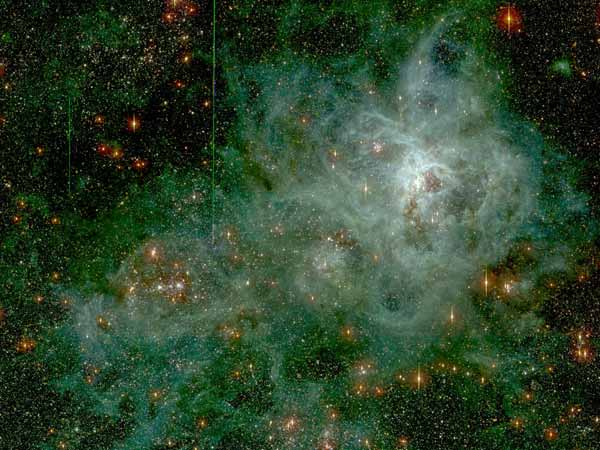
|
Credit & Copyright: U. Michigan,
Lucent
Explanation:
30 Doradus is an immense star forming region in a nearby galaxy known
as the Large Magellanic Cloud.
Its
spidery appearance is responsible for its popular name, the
Tarantula Nebula, except that
this tarantula is about 1,000 light-years across, and
165,000 light-years away in the southern constellation
Dorado.
If it were at the distance of the
Orion Nebula,
the nearest stellar nursery to Earth, it
would appear to cover about 30 degrees
on the sky or about 60
full moons.
The
above image was taken with the
Big Throughput Camera
and is shown in representative colors.
The spindly arms of the
Tarantula Nebula surround the
NGC 2070 star cluster
which contains some of the intrinsically brightest,
most massive stars known.
This celestial
Tarantula is also seen near the site of the
closest recent Supernova.
|
January February March April May June July August September October November December |
| ||||||||||||||||||||||||||||||||||||||||||||||||
NASA Web Site Statements, Warnings, and Disclaimers
NASA Official: Jay Norris. Specific rights apply.
A service of: LHEA at NASA / GSFC
& Michigan Tech. U.
Based on Astronomy Picture
Of the Day
Publications with keywords: nebula - star cluster - LMC - Tarantula Nebula - 30 Doradus
Publications with words: nebula - star cluster - LMC - Tarantula Nebula - 30 Doradus
See also:
- APOD: 2025 October 26 Á Halloween and the Ghost Head Nebula
- APOD: 2025 October 8 Á NGC 7380: The Wizard Nebula
- APOD: 2025 July 4 Á NGC 6946 and NGC 6939
- Young Star Cluster NGC 346
- APOD: 2025 March 18 Á LDN 1235: The Shark Nebula
- Young Star Cluster NGC 1333
- APOD: 2024 June 11 Á Colorful Stars and Clouds near Rho Ophiuchi
